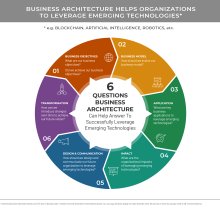In this installment of StraightTalk, we explore another topic relevant to our digital future: blockchain and distributed ledger technology. We spoke with business and technology strategist, Josué Batista, who gives us the straight talk on how business architecture can help organizations to leverage blockchain and distributed ledger technology for value. This post is based on our recent interview with him.
Disclaimer: we’ve made some adjustments for our typical StraightTalk-style: the headings below represent StraightTalk asking the questions and our guest, Josué, responds in turn.
Make sure to check out Josué’s interview firsthand in our StraightTalk podcast 5-Minutes With Josué Batista.
Start from the beginning. What is blockchain?
Josué: “I think we need to level set on a very important point here. Bitcoin is not blockchain. There is a lot of confusion out there in this space with the cryptocurrencies, but blockchain is actually the underlying technology that facilitates bitcoin and many other cryptocurrencies. That technology is at the heart of what we call distributed ledger technologies or DLT.
Blockchain is an architectural concept. It offers an open, distributed ledger, and records transactions between parties – in a verifiable and permanent way. So basically, with blockchain, we have a distributed ledger and decentralization (i.e. peer-to-peer interaction for transactions). It also provides immutability because blockchain allows us to do two things from a database perspective: write something on it and read something from it – we cannot change or edit it like a traditional database. It also offers hashing and cryptography to the level that until today no one has been able to crack or crash a blockchain or cryptocurrency because of the hashing mechanisms they have.”
What do you think are some of the most important applications of blockchain for organizations?
Josué: “Multiparty collaborations. Because blockchain is distributed and decentralized, you can eliminate third parties. Blockchain also allows for smart contracts (and some allow for smart legal contracts), so process optimization is a tremendous opportunity. We already mentioned the cryptography and so security is at the heart of that. Also, regulators can benefit from transparency and reliability.
Blockchain is also good in scenarios where we need to protect intellectual property or where there are specific transactions that we want to keep between certain parties. The information imbalance that exists today is eliminated because of blockchain.
One of the most interesting aspects that I see is digital assets. As we transform the things we use day-to-day into digital assets, it opens the door to a complete revolution in terms of how we trade information and the assets themselves. Within this context there are many use cases. For example, health care business cases, corporate board voting and even public voting.
Identity management is another area that is growing tremendously. For example, the land records in Cook County Illinois within the United States are now in blockchain. It’s a way to marry the identity of an individual to their land management records.
Blockchain can be that security or decision vault when it comes to protecting internet of things (IoT) devices as well.
Blockchain is very comprehensive and something that I believe is going to progressively get better in terms of value. Right now, some people say that blockchain is a hammer looking for a nail. I like to think of it as hot sauce – you don’t want to drink a glass of it, but you can use it to enhance existing business processes.”
How can business architecture help organizations to leverage blockchain for value?
Josué: “I think this is the most exciting opportunity of all, because at the heart business architecture is helping everyone with ambiguity. We know that ambiguity is everywhere. I use the term clarity of intention. We want to arrive at clarity of intention in terms of a business strategy and implementation strategy. That is where business architecture provides the most value. Sometimes organizations can be reactionary and with the tactical demands that they have, they jump from strategy into projects with a limited understanding of what the impacts are, what the scope is, and what the value proposition is.
So, business architecture is key for success. It is a tremendous opportunity, not just for blockchain but for other technologies as well, such as artificial intelligence or robotics. All of these emerging technologies will rely on a greater understanding of the business from a business architecture perspective. I think the opportunities here are great.”
Because we love six-word memoirs, how would you sum all of that up in 6 words?
Josué: “The future is distributed and decentralized. Emerging technologies are going to bring a whole different approach to how we define business models as well as the way the business architecture is going to be shared across organizations. In addition, peer-to-peer interactions are going to replace brokers and third parties, so the future will be distributed and decentralized.”
The diagram below helps to sum up our discussion here:
What are the top things business architects should do to educate themselves about blockchain and distributed ledger technology?
Josué: “Business architects should look at the bigger picture of distributed ledger technologies. It is more comprehensive and is the distributed way to understand transactions with consensus among parties that do not necessarily have to trust each other. So, business architects should:
- First, gain an understanding of what this concept means, especially keeping in mind that it is an architectural concept
- Second, keep up to date on how blockchain and distributed ledgers are impacting your industry.”
Anything else?
Josué: “Remain thirsty for knowledge and find the applicability of these technologies from a business perspective. That is the key.”
More Good Stuff…
5-Minutes With Josué Batista (StraightTalk podcast): Just in case you missed the link in our introduction, make sure to check out Josué’s podcast, which was the basis for this post, where he speaks with us about what blockchain is and how business architecture can help an organization to fully leverage it.
What and Why First (Josué Batista): Josué has created an excellent blog to help business and technology leaders develop the resources and capabilities needed to gain and sustain advantage in competitive markets — both traditional and emerging. Here are a few selected resources from What and Why First:
- What is Business Architecture and Why Should You Care? – Article and Video
- The Value Proposition of Business Architecture – Article
- Blockchain And Seven Technologies That Are Changing The World – Article and Video
- Blockchain And Value Creation – What You Should Know And Why – Video
Selected Free Resources to Learn About Blockchain: Josué has recommended a few key resources to help you learn about blockchain:
- SAP Leonardo – An Introduction to Blockchain – Free Online Course
- Blockchain: Understanding Its Uses and Implications (LFS170) – Free Online Course
- Introduction to Hyperledger Technologies (LFS171) – Free Online Course
Blockchain Explained: What It Is and Isn’t, and Why It Matters (McKinsey): An article about how companies can drive business value through blockchain, and also how organizations can determine when blockchain is and isn’t the right innovation.
Blockchain Beyond the Hype: What is the Strategic Business Value? (McKinsey): Guidance on how organizations should approach their blockchain strategies.
Building Block(chain)s for a Better Planet (World Economic Forum): An excellent piece on how we can harness the unique opportunity presented by the Fourth Industrial Revolution to help address environmental issues and transform how we manage our shared global environment. (Make sure to download the PDF.)
How the Blockchain Will Radically Transform the Economy (TED Talk): A TED Talk by Bettina Warburg describing how the blockchain will eliminate the need for centralized institutions like banks or governments to facilitate trade, evolving age-old models of commerce and finance into something far more interesting: a distributed, transparent, autonomous system for exchanging value. “While blockchain technology is relatively new, it is actually a continuation of a very human story. As humans, we find ways to lower uncertainty about one another so that we can exchange value.”

